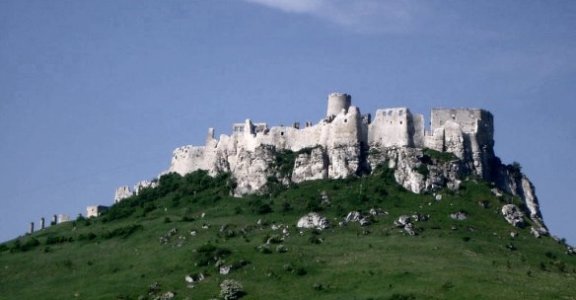UNESCO – cultural monuments of Slovakia
SPIS CASTLE
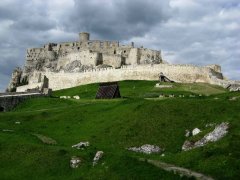 SPIS CASTLE – is the biggest middle-age complex in Middle Europe. Castle ruins cover a travertine hill called the Spis Castle Hill. The castle was first mentioned in 12th century. It was vastly damaged during fire in the 1780 and has not been renewed since. During the past few years, the castle has undergone a complete reconstruction with conservation and also a new exposition was built to revive this exceptional monument. It was accepted into the UNESCO list in 1993.
SPIS CASTLE – is the biggest middle-age complex in Middle Europe. Castle ruins cover a travertine hill called the Spis Castle Hill. The castle was first mentioned in 12th century. It was vastly damaged during fire in the 1780 and has not been renewed since. During the past few years, the castle has undergone a complete reconstruction with conservation and also a new exposition was built to revive this exceptional monument. It was accepted into the UNESCO list in 1993.
BANSKA STIAVNICA
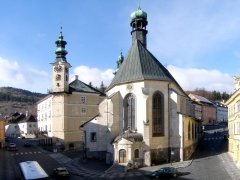 BANSKA STIAVNICA – the most famous mining town in Slovakia. Mining and metalworking in this area started during the Bronze Age but town and mining rights were not received until 1238. First mining university was established in 1735 by the decree of Maria Teresia. It was the only university of its kind in the world and it stood as a model for the later formation of Polytechnic in Paris. There are about 360 monuments in the town. They together create a unique complex of cultural and historical value which is set in beautiful environment of the Stiavnicke Hills.
BANSKA STIAVNICA – the most famous mining town in Slovakia. Mining and metalworking in this area started during the Bronze Age but town and mining rights were not received until 1238. First mining university was established in 1735 by the decree of Maria Teresia. It was the only university of its kind in the world and it stood as a model for the later formation of Polytechnic in Paris. There are about 360 monuments in the town. They together create a unique complex of cultural and historical value which is set in beautiful environment of the Stiavnicke Hills.
BARDEJOV
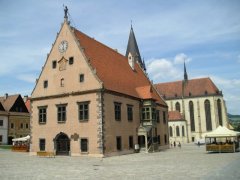 BARDEJOV – is considered the most gothic town of Slovakia. It’s been a part of UNESCO since 2000. It was first mentioned in the 13th century. The town had healing spas, mills, brewery, brick factory and it was a center of commerce and craft industry. The central square is the most important part of the town. There are lots of urban, architectonic, historical and cultural monuments. One of the most important monuments is surely the gothic church of St. Egidius from the 14th century, old town-hall from 1511, gothic burgher’s houses, the church of St. Franciscans, Greek-Catholic church, town fortification, former Jew spas, agricultural buildings and synagogues.
BARDEJOV – is considered the most gothic town of Slovakia. It’s been a part of UNESCO since 2000. It was first mentioned in the 13th century. The town had healing spas, mills, brewery, brick factory and it was a center of commerce and craft industry. The central square is the most important part of the town. There are lots of urban, architectonic, historical and cultural monuments. One of the most important monuments is surely the gothic church of St. Egidius from the 14th century, old town-hall from 1511, gothic burgher’s houses, the church of St. Franciscans, Greek-Catholic church, town fortification, former Jew spas, agricultural buildings and synagogues.
VLKOLINEC
 VLKOLINEC – lies at the southern bottom of Sidorovo, at an altitude of 718m. It was first mentioned in 1376. It has more than 40 original, inhabited wooden houses which are a demonstration of the former Slovak mountain village. There is a museum – a peasant’s house with an exposition of former habitation and also an information center. Vlkolinec is the only village in Slovakia that is not touched by modern building development. There is also a wooden belfry from 1770 to be seen. The former emblem of the village is formed by a heraldic rose with a coniferous tree on a meadow.
VLKOLINEC – lies at the southern bottom of Sidorovo, at an altitude of 718m. It was first mentioned in 1376. It has more than 40 original, inhabited wooden houses which are a demonstration of the former Slovak mountain village. There is a museum – a peasant’s house with an exposition of former habitation and also an information center. Vlkolinec is the only village in Slovakia that is not touched by modern building development. There is also a wooden belfry from 1770 to be seen. The former emblem of the village is formed by a heraldic rose with a coniferous tree on a meadow.
LEVOCA
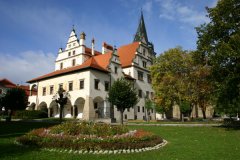 LEVOCA – is a town reservation which thanks to many monuments belongs to the most beautiful historical towns in Slovakia. The most unique monument is the Church of St. Jacob with its 11 gothic and renaissance wing-altars, including the tallest wooden altar in the world (18,6 m). The town has a huge middle-age square surrounded by renaissance houses, a renaissance town-hall, two rare churches with baroque interior, classicistic buildings of the county house and evangelic church. The historical center of the town is surrounded by massive wall system with a length of 2,5 km. The historical center has been a part of UNESCO since 2009.
LEVOCA – is a town reservation which thanks to many monuments belongs to the most beautiful historical towns in Slovakia. The most unique monument is the Church of St. Jacob with its 11 gothic and renaissance wing-altars, including the tallest wooden altar in the world (18,6 m). The town has a huge middle-age square surrounded by renaissance houses, a renaissance town-hall, two rare churches with baroque interior, classicistic buildings of the county house and evangelic church. The historical center of the town is surrounded by massive wall system with a length of 2,5 km. The historical center has been a part of UNESCO since 2009.
ZEHRA – CHURCH OF THE HOLY SPIRIT
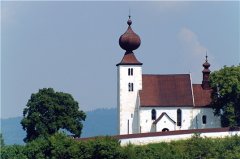 ZEHRA – is known for its rare Rome-catholic church of the Holy Spirit. It is a two-aisle building built in roman and early gothic styles. It was built in 1275. The church paintings are of a high quality and have a unique thematic diversity showing different biblical stories and legends.
ZEHRA – is known for its rare Rome-catholic church of the Holy Spirit. It is a two-aisle building built in roman and early gothic styles. It was built in 1275. The church paintings are of a high quality and have a unique thematic diversity showing different biblical stories and legends.
SPISSKA KAPITULA
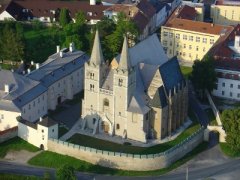 SPISSKA KAPITULA – a part of Spisske Podhradie, a sacral town that has always been a center of the church in the Spis region. It was a residence of the Spis bishop since 1776. A late-roman Cathedral of St. Martin is its most important part. The fortification with its 2 gates was built in 14th century and it has undergone several reconstructions since. The forming of the Spisska Kapitula was finished by reconstructing the priory into the late-renaissance bishop’s palace (1652), building the clock tower (1739) and rearrangement of the baroque garden and canon houses.
SPISSKA KAPITULA – a part of Spisske Podhradie, a sacral town that has always been a center of the church in the Spis region. It was a residence of the Spis bishop since 1776. A late-roman Cathedral of St. Martin is its most important part. The fortification with its 2 gates was built in 14th century and it has undergone several reconstructions since. The forming of the Spisska Kapitula was finished by reconstructing the priory into the late-renaissance bishop’s palace (1652), building the clock tower (1739) and rearrangement of the baroque garden and canon houses.
TVRDOSIN – CHURCH OF ALL SAINTS
 TVRDOSIN – is proud of its oldest monument – the gothic wooden roman-catholic Church of All Saints. It was enlisted into UNESCO in 2007 along with 7 other wooden churches. It comes from 15th century and it was rebuilt in the renaissance style in 17th century.
TVRDOSIN – is proud of its oldest monument – the gothic wooden roman-catholic Church of All Saints. It was enlisted into UNESCO in 2007 along with 7 other wooden churches. It comes from 15th century and it was rebuilt in the renaissance style in 17th century.
HERVARTOV – CHURCH OF ST. FRANCIS OF ASSISI
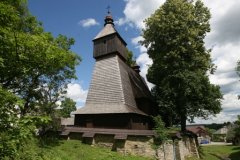 HERVARTOV – is known for its gothic wooden roman-catholic church that was built in 15th century. There are many old documents to be found from the 150 year-long era when the church belonged to evangelics. The most important parts of its interior are the gothic board paintings and wall paintings.
HERVARTOV – is known for its gothic wooden roman-catholic church that was built in 15th century. There are many old documents to be found from the 150 year-long era when the church belonged to evangelics. The most important parts of its interior are the gothic board paintings and wall paintings.
KEZMAROK
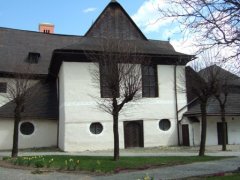 KEZMAROK – and its evangelic wooden articular church became a national cultural monument in 1985 and it was enlisted into UNESCO in 2009. The former church was built in 1687–1688 and its reconstruction began in 1717 by the protestants from Kezmarok. The builders of the church had to meet several conditions – the church had to be built outside the town fortification, only one in each town and two in one county. It had to be sponsored by the evangelic church only and it had to be built from the cheapest material. That’s why the church is built out of wood. Even the nails had to be wooden. The facade is made out of clay and it is typical by its round windows.
KEZMAROK – and its evangelic wooden articular church became a national cultural monument in 1985 and it was enlisted into UNESCO in 2009. The former church was built in 1687–1688 and its reconstruction began in 1717 by the protestants from Kezmarok. The builders of the church had to meet several conditions – the church had to be built outside the town fortification, only one in each town and two in one county. It had to be sponsored by the evangelic church only and it had to be built from the cheapest material. That’s why the church is built out of wood. Even the nails had to be wooden. The facade is made out of clay and it is typical by its round windows.
LESTINY
 LESTINY – is known for its wooden articular church that was built in 1688–1689. A belfry was added in 1977 and it was connected with the church later on by a covered staircase. The interior comes from 17th and 18th century and has many paintings. The building of the church was initiated by Job Zmeskal who was the captain of the castle guard. One of the most famous Slovak writers – Pavol Orszagh Hviezdoslav was baptized in this church.
LESTINY – is known for its wooden articular church that was built in 1688–1689. A belfry was added in 1977 and it was connected with the church later on by a covered staircase. The interior comes from 17th and 18th century and has many paintings. The building of the church was initiated by Job Zmeskal who was the captain of the castle guard. One of the most famous Slovak writers – Pavol Orszagh Hviezdoslav was baptized in this church.
HRONSEK
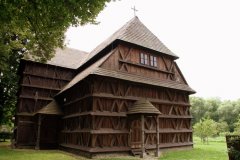 HRONSEK – is known for its wooden articular evangelic church that was built with a belfry in 1726. The courtyard is decorated by 4 lime trees that were planted when the church was consecrated. Andrej Sladkovic – a famous Slovak poet was married in this church.
HRONSEK – is known for its wooden articular evangelic church that was built with a belfry in 1726. The courtyard is decorated by 4 lime trees that were planted when the church was consecrated. Andrej Sladkovic – a famous Slovak poet was married in this church.
BODRUZAL – CHURCH OF ST. NICOLAS
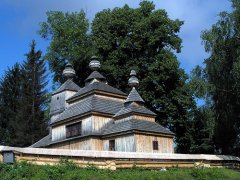 BODRUZAL – can be proud for its Greek-catholic wooden church that was built in 1658 and is on of the oldest of its kind in Slovakia. It has 3 towers (eastern is the smallest, western is the tallest – with belfry) Interior is decorated by baroque wall paintings. The area is surrounded by a log fence.
BODRUZAL – can be proud for its Greek-catholic wooden church that was built in 1658 and is on of the oldest of its kind in Slovakia. It has 3 towers (eastern is the smallest, western is the tallest – with belfry) Interior is decorated by baroque wall paintings. The area is surrounded by a log fence.
LADOMIROVA – CHURCH OF ST. MICHAEL ARCHANGEL
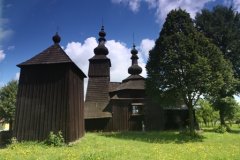 LADOMIROVA – is known for its Greek-catholic church that comes from 1742 and was built without the use of nails. A wooden log belfry is also a part of the church complex as well as a cemetery. Interior comes from 18th century and is valued mainly for the iconostasis and altar. A part of the church was destroyed during world war the second. The belfry was also damaged by the falling lime-tree, but was reconstructed back to its original state. There are also several icons and other service items enlisted in the cultural monument register.
LADOMIROVA – is known for its Greek-catholic church that comes from 1742 and was built without the use of nails. A wooden log belfry is also a part of the church complex as well as a cemetery. Interior comes from 18th century and is valued mainly for the iconostasis and altar. A part of the church was destroyed during world war the second. The belfry was also damaged by the falling lime-tree, but was reconstructed back to its original state. There are also several icons and other service items enlisted in the cultural monument register.
RUSKA BYSTRA – CHURCH OF ST. NICOLAS THE BISHOP
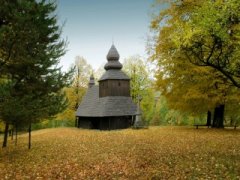 RUSKA BYSTRA – is known for its Greek-catholic wooden church that was built between 1720 and 1730. It has 2 towers oriented to the east and west. Interior comes from 18th century and is mainly of baroque and rococo style. Icons are placed on the walls and the most unique one is the icon of crucifixion that was completely renovated.
RUSKA BYSTRA – is known for its Greek-catholic wooden church that was built between 1720 and 1730. It has 2 towers oriented to the east and west. Interior comes from 18th century and is mainly of baroque and rococo style. Icons are placed on the walls and the most unique one is the icon of crucifixion that was completely renovated.
